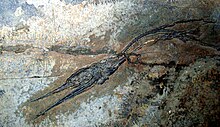
Back سمكة عظائية Arabic Saurichthys Spanish Saurichthys Italian サウリクティス Japanese Saurichthys Dutch Saurichthys Portuguese
| Saurichthys Temporal range: Triassic
~ | |
|---|---|

| |
| Saurichthys fossil | |
| Scientific classification | |
| Domain: | Eukaryota |
| Kingdom: | Animalia |
| Phylum: | Chordata |
| Class: | Actinopterygii |
| Order: | †Saurichthyiformes |
| Family: | †Saurichthyidae |
| Genus: | †Saurichthys Agassiz, 1834 |
| Type species | |
| †Saurichthys apicalis Agassiz, 1834
| |
| Species | |
| |
| Synonyms | |


Saurichthys (from Greek: σαῦρος saûros, 'lizard' and Greek: ἰχθῦς ikhthûs 'fish') is an extinct genus of predatory ray-finned fish from the Triassic Period. It is the type genus of the family Saurichthyidae (Changhsingian-Middle Jurassic), and the most speciose and longest lasting genus in the family. This family also includes the Permian Eosaurichthys (China) and the Jurassic Saurorhynchus (= Acidorhynchus)[4] from Europe and North America, though it may be more appropriate to treat these as subgenera of Saurichthys, due to the genus Saurichthys otherwise being paraphyletic.[5]
Fossils of Saurichthys have been found on all continents except South America and Antarctica.[6][7][8] It inhabited both marine and freshwater environments.[8][9] The oldest fossils of Saurichthys were recovered from the Wordie Creek Formation in East Greenland and are Griesbachian (Induan, Early Triassic) in age.[10]
Over 50 species of Saurichthys have been described (see list below). The species differ in size and show variability in their skeletal features. The latter can potentially be ascribed to changes in major developmental genes.[11] The use of subgenera (Eosaurichthys, Costasaurichthys, Lepidosaurichthys, Saurorhynchus, Sinosaurichthys) in the literature reflects differences in morphology between species groups.[12] Several species that were described predominantly in the 19th century are based on fragmentary fossils (often isolated teeth). These are mostly considered invalid species by modern taxonomic standards.
Louis Agassiz, who described the type species of Saurichthys in 1834, named it the "lizard fish" because of skeletal features that he thought were intermediate to reptiles and fishes.
Their exact phylogenetic position is uncertain, though it is agreed that they are not members of Neopterygii. Historically, they have been seen as close relatives of the Acipenseriformes (which includes living sturgeon and paddlefish) as part of the Chondrostei, though this has been strongly questioned by modern studies, which suggests that it may lie outside the Actinopterygii crown group.[5]
- ^ a b c Stensiö, E. (1925). "Triassic Fishes from Spitzbergen, Part II". Kungliga Svenska Vetenskapsakademiens Handlingar. 3: 1–126.
- ^ a b Cartanyà, J. (1999). "An overview of the Middle Triassic actinopterygians from Alcover, Mont-ral and El Pinetell (Catalonia, Spain)". In G. Arratia; H. P. Schultze (eds.). Mesozoic Fishes 2—Systematics and Fossil Record. München: Friedrich Pfeil. pp. 535–551.
- ^ Scheyer, Torsten M.; Romano, Carlo; Jenks, Jim; Bucher, Hugo (2014). "Early Triassic Marine Biotic Recovery: The Predators' Perspective". PLOS ONE. 9 (3): e88987. Bibcode:2014PLoSO...988987S. doi:10.1371/journal.pone.0088987. PMC 3960099. PMID 24647136.
- ^ Kogan, Ilja (2016). "Acidorhynchus Stensiö, 1925 or Saurorhynchus Reis, 1892: how to call the Jurassic saurichthyid?". Neues Jahrbuch für Geologie und Paläontologie, Abhandlungen. 279 (1): 123–126. doi:10.1127/njgpa/2016/0545.
- ^ a b Argyriou, Thodoris; Giles, Sam; Friedman, Matt; Romano, Carlo; Kogan, Ilja; Sánchez-Villagra, Marcelo R. (December 2018). "Internal cranial anatomy of Early Triassic species of †Saurichthys (Actinopterygii: †Saurichthyiformes): implications for the phylogenetic placement of †saurichthyiforms". BMC Evolutionary Biology. 18 (1): 161. Bibcode:2018BMCEE..18..161A. doi:10.1186/s12862-018-1264-4. ISSN 1471-2148. PMC 6211452. PMID 30382811.
- ^ Saurichthys at Fossilworks.org
- ^ Mutter, R. J.; Cartanyà, J.; Basaraba, S. A. U. (2008). "New evidence of Saurichthys from the Lower Triassic with an evaluation of early saurichthyid diversity". In G. Arratia; H.-P. Schultze; M. V. H. Wilson (eds.). Mesozoic Fishes 4—Homology and phylogeny. München: Friedrich Pfeil. pp. 103–127.
- ^ a b Cite error: The named reference
Romano2012was invoked but never defined (see the help page). - ^ Kligman, Ben T.; Parker, William G.; Marsh, Adam D. (2017). "First record of Saurichthys (Actinopterygii) from the Upper Triassic (Chinle Formation, Norian) of western North America". Journal of Vertebrate Paleontology. 37 (5): e1367304. Bibcode:2017JVPal..37E7304K. doi:10.1080/02724634.2017.1367304.
- ^ Kogan, Ilja (2011). "Remains of Saurichthys (Pisces, Actinopterygii) from the Early Triassic Wordie Creek Formation of East Greenland" (PDF). Bulletin of the Geological Society of Denmark. 93: 93–100. doi:10.37570/bgsd-2011-59-09.
- ^ Schmid, Leonhard; Sánchez-Villagra, Marcelo R. (2010). "Potential genetic bases of morphological evolution in the triassic fish Saurichthys". Journal of Experimental Zoology Part B: Molecular and Developmental Evolution. 314B (7): 519–526. Bibcode:2010JEZB..314..519S. doi:10.1002/jez.b.21372. PMID 20853419.
- ^ Silvio Renesto; Fabio Magnani; Rudolf Stockar (2021). "A new species of Saurichthys (Actinopterygii: Saurichtydae) from the Middle Triassic of Monte San Giorgio". Rivista Italiana di Paleontologia e Stratigrafia. 127 (1): 49–71. doi:10.13130/2039-4942/15143.
© MMXXIII Rich X Search. We shall prevail. All rights reserved. Rich X Search